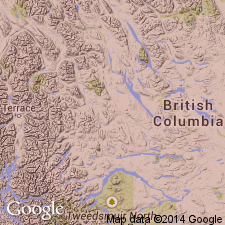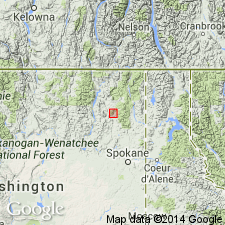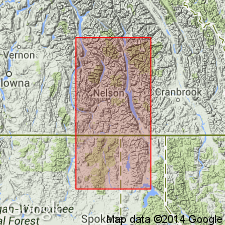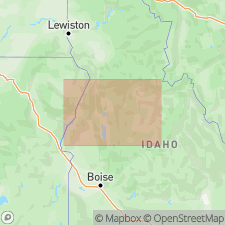
- Usage in publication:
-
- Windermere series
- Modifications:
-
- Named
- AAPG geologic province:
-
- Northern Rocky Mountain region
Summary:
Windermere series named and divided into Toby conglomerate (base) and Horsethief formation (top) in this report. No type locality designated. Probably named for Windermere mining district, BC, CN in the Northern Rocky Mountain region. Unconformably overlies Purcell series [= Belt Series in US (Wilmarth, 1938, US geologic names lexicon, USGS Bull. 896, p. 1746)] and underlies Upper Cambrian Ottertail formation in the Windermere area. Is thought to be equivalent to Summit series of the International Boundary area, and to the Hector and Carrol Creek formations. Is of Late Precambrian age.
Source: GNU records (USGS DDS-6; Denver GNULEX).

- Usage in publication:
-
- Windermere Group*
- Modifications:
-
- Adopted
- Age modified
- AAPG geologic province:
-
- Okanogan province
Summary:
Windermere series of Walker (1926) is adopted as the Windermere Group. Age is Precambrian Z.
Source: GNU records (USGS DDS-6; Menlo GNULEX).

- Usage in publication:
-
- Windermere Supergroup [Canada
- Group in U.S.]
- Modifications:
-
- Age modified
- AAPG geologic province:
-
- Okanogan province
- Idaho Mountains province
- British Columbia
Summary:
Age of the Windermere Group is [everywhere] revised from Middle(?) and Late Proterozoic to: Late Proterozoic based on isotopic age data (Sm/Nd whole-rock age of about 760 Ma) and regional stratigraphic relations.
Source: GNU records (USGS DDS-6; Menlo GNULEX).

- Usage in publication:
-
- Windermere Supergroup*
- AAPG geologic province:
-
- Idaho Mountains province
Summary:
Pg. 8+. Author applies name Windermere Supergroup of Canadian geologists rather than preferred name Windermere Group of the U.S. Geological Survey. Formal group-rank units of the Windermere Supergroup are not used in this report. Isolation of the central Idaho exposures from sections with published descriptions and the lack of temporal context made it difficult to develop specific correlations. In central Idaho the Windermere Supergroup is divided into 4 packages, informally designated Gospel Peaks successions A through D. These are divided into newly named formations, in ascending order: (A) Plummer Point, Square Mountain, and Anchor Meadow Formations; (B) Edwardsburg, Moores Station, and Goldman Cut Formations; (C) Moores Lake and Missouri Ridge Formations; and (D) Umbrella Butte Formation. Age of Windermere is Neoproterozoic to possibly early Paleozoic (Cambrian?).
[For the purpose of maintaining a consistent and uniform hierarchical classification scheme (e.g., formation, group, supergroup) of formally named lithostratigraphic units in the U.S., the Windermere Group is the preferred name of the USGS.]
Source: Publication.
For more information, please contact Nancy Stamm, Geologic Names Committee Secretary.
Asterisk (*) indicates published by U.S. Geological Survey authors.
"No current usage" (†) implies that a name has been abandoned or has fallen into disuse. Former usage and, if known, replacement name given in parentheses ( ).
Slash (/) indicates name conflicts with nomenclatural guidelines (CSN, 1933; ACSN, 1961, 1970; NACSN, 1983, 2005, 2021). May be explained within brackets ([ ]).

